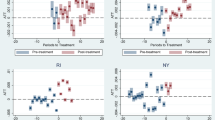Abstract
Since 1979 German federal maternity leave and benefit policy has given women incentives to stay at home and take care of their newborn and youngest children. In 1986 this leave and benefit policy was changed in several ways, turning it into a powerful instrument for delaying mothers' return to work after childbirth. Using a flexible duration dependence estimation technique for proportional hazards due to Prentice and Gloeckler (1978) and applied to grouped durations by Meyer (1987, 1990), we estimate post childbirth return to work hazards for women during the federally protected leave protection period and immediately upon completion of this leave period. During the leave mothers are less likely to return to work the longer is the time left in the leave protection period; however, this result cannot be attributed generally to high levels of maternity benefits. When the leave protection period ends, mothers with strong labor force attachment who are still on leave return to their jobs.
Similar content being viewed by others
References
Blau D, Robins PK (1991) Child Care Demand and Labor Supply of Young Mothers over Time. Demography 28:333–351
Bundesminister für Jugend, Familie, Frauen und Gesundheit [Minister for Youth, Family, Women and Health] (ed, 1989) Erziehungsgeld, Erziehungsurlaub und Anrechnung von Erziehungszeiten in der Rentenversicherung [Child-Rearing Benefit, Parental Leave and Credits for Child Rearing in the Social Security System], Schriftenreihe des Bundesministers für Jugend, Familie, Frauen und Gesundheit, Band 243. Kohlhammer, Berlin
Cox DR (1972) Regression Models and Life Tables (with discussion). Journal of the Royal Statistical Society B 34:187–220
Cox DR (1975) Partial Likelihood. Biometrika 62:269–276
Gesetz über die Gewährung von Erziehungsgeld und Erziehungsurlaub (Bundeserziehungsgeldgesetz - BerzGG) [Law to Guarantee the Child-Rearing Benefit and Parental Leave (Federal Child-Rearing Benefit Law)]. Bundesgesetzblatt, various issues, 1985–1994
Gesetz zum Schutze der erwerbstätigen Mutter (Mutterschutzgesetz - MSchGG) [Law for the Protection of the Employed Mother (Mother Protection Law)]. Bundesgesetzblatt, various issues, 1968–1989
Gustafsson SS, Wetzels C, Vlasblom JD, Dex S (1996) Women's Labor Force Transitions in Connection with Childbirth. A Panel Data Comparison between Germany, Sweden and Great Britain. Journal of Population Economics 9:223–246
Joesch JM (1994) Children and the Timing of Women's Paid Work After Childbirth: A Further Specification of the Relationship. Journal of Marriage and the Family 56:429–440
Joesch JM (1995) Paid Leave and the Timing of Women's Employment Surrounding Birth. Paper prepared for the Annual Meeting of the Population Association of America, San Francisco, April 1995
Klein T, Braun U (1995) Der berufliche Wiedereinstieg von Müttern zwischen abnehmendem Betreuungsaufwand und zunehmender Dequalifizierung. Zeitschrift für Soziologie 1:58–68
Klerman JA, Leibowitz A (1990) Child Care and Women's Return to Work After Childbirth. The American Economic Review 80:284–288
Klerman JA, Leibowitz A (1995) Labor Supply Effects of State Maternity Leave Legislation. Paper prepared for ILR-Cornell Institute for Labor Market Policies Conference, Gender and Family Issues in the Workplace. Ithaca, April 1995
Leibowitz A, Klerman JA, Waite LJ (1992) Employment of New Mothers and Child Care Choice. The Journal of Human Resources 27:112–133
Meyer BD (1987) Semiparametric Estimation of Duration Models, Ph.D. Thesis. MIT
Meyer BD (1990) Unemployment Insurance and Unemployment Spells. Econometrica 58:757–782
O'Connell M (1990) Maternity Leave Arrangements: 1961-85. In: Work and Family Patterns of American Women. Current Population Reports, Special Studies Series P-23, No. 165:11–27
Organization for Economic Co-operation and Development (OECD) (1995) Working Party on Employment. Draft Chapter 5. Long-Term Leave for Parents in OECD Countries, Paris
Prentice RL, Gloeckler LA (1978) Regression Analysis of Grouped Survival Data with Application to Breast Cancer Data. Biometrics 34:57–67
Ruhm CJ, Teague JL (1995) Parental Leave Policies in Europe and North America. Paper prepared for ILR-Cornell Institute for Labor Market Policies Conference, Gender and Family Issues in the WOrkplace, Ithaca, April 1995
Schwarze J (1994) Simulating German Income and Social Security Tax Payments Using the GSOEP. Cross-National Studies in Aging Program Project Paper No. 19, Syracuse University
Statistisches Bundesamt, unpublished figures on women's labor force participation by age of children, 1987 and 1992, Wiesbaden
Wagner G, Burkhausen RV, Sehringer F (1993) The Syracuse University English Language Public User File of the German Socio-Economic Panel. The Journal of Human Resources 28:429–433
Wenk D, Garrett P (1992) Having a Baby: Some Predictions of Maternal Employment Around Childbirth. Gender and Society 6:49–65
Author information
Authors and Affiliations
Additional information
The second author gratefully acknowledges financial support by the National German Science Foundation (Deutsche Forschungsgemeinschaft) (Grant No. Wa 547/2-1). The authors would like to thank Richard Burkhauser, Barbara Butrica, John F. Ermisch, Joachim Frick, Siv Gustafsson, Philip Merrigan, Johannes Schwarze, Eileen Trzcinski, Jan-Dirk Vlasblom, Gert Wagner, Sheng Zhu and two anonymous referees for their help and suggestions. Remaining errors are of course, our own. Responsible editors: Siv S. Gustafsson, John F. Ermisch.
Rights and permissions
About this article
Cite this article
Ondrich, J., Spiess, C.K. & Yang, Q. Barefoot and in a German kitchen: Federal parental leave and benefit policy and the return to work after childbirth in Germany. J Popul Econ 9, 247–266 (1996). https://doi.org/10.1007/BF00176687
Received:
Accepted:
Issue Date:
DOI: https://doi.org/10.1007/BF00176687




